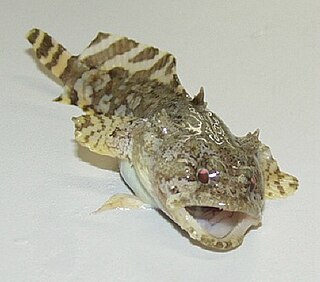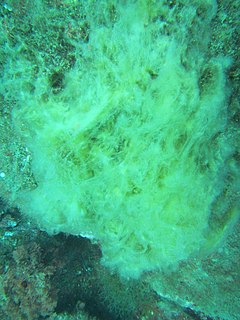
The Squaliformes are an order of sharks that includes about 126 species in seven families.

The electric rays are a group of rays, flattened cartilaginous fish with enlarged pectoral fins, composing the order Torpediniformes. They are known for being capable of producing an electric discharge, ranging from 8 to 220 volts, depending on species, used to stun prey and for defense. There are 69 species in four families.

Batrachoididae is the only family in the ray-finned fish order Batrachoidiformes. Members of this family are usually called toadfish, or "frogfish": both the English common name and scientific name refer to their toad-like appearance.

Sternoptyx is an oceanic ray-finned fish genus which belongs in the family Sternoptychidae. This is the type genus of the Sternoptychidae, as well as the marine hatchetfish subfamily Sternoptychinae.

Rabbitfishes or spinefoots are perciform fishes in the family Siganidae. The 29 species are in a single genus, Siganus. In some now obsolete classifications, the species having prominent face stripes—colloquially called foxfaces–are in the genus Lo. Other species, such as the masked spinefoot, show a reduced form of the stripe pattern. Rabbitfishes are native to shallow waters in the Indo-Pacific, but S. luridus and S. rivulatus have become established in the eastern Mediterranean via Lessepsian migration. They are commercially important food fish, and can be used in the preparation of dishes such as bagoong.

Xenacanthida is an order of prehistoric sharks that appeared during the Lower Carboniferous period. The order includes the families Xenacanthidae, Diplodoselachidae, and Orthacanthidae. The most notable members of the group are the genera Xenacanthus and Orthacanthus. Some Xenacanthida may have grown to lengths of 5 m (16 ft). Most forms had large serrated spines extending backwards from the neck. Xenacanthus had characteristic teeth. Most xenacanths died out at the end of the Permian in the Permian Mass Extinction, with only a few forms surviving into the Triassic period. They were native to freshwater, marginal marine and shallow marine habitats.

Pelagophyceae is a class of heterokont algae. It is the sister group of Dictyochophyceae.

The Palaeonisciformes are an extinct order of early ray-finned fishes (Actinopterygii) which began in the Late Silurian and ended in the Late Cretaceous. The name of the order is derived from the Greek words paleo (ancient) and ὀνίσκος, probably pertaining to the organization of the fishes' scales, similar to the exoskeletal plating of woodlice.

Aetobatus is a genus of eagle rays native to the Atlantic, Pacific and Indian Oceans. It was formerly placed in Myliobatidae, but is now placed in its own family based on salient differences from myliobatids, especially the pectoral fins joining the head at the level of the eyes.

The yellowtail flounder, also known as the rusty dab, is a species of flatfish in the family Pleuronectidae. Reaching 56 cm (22 in) in length, it has reddish brown upperparts, pale underparts and yellow fins. Both its eyes are on the right (upper) side of its body. Found in the western North Atlantic, it has been fished commercially by North American fisheries for food. A victim of overfishing, the yellowtail flounder is categorized as "Vulnerable" by the International Union for Conservation of Nature.

Kolponomos is an extinct genus of carnivoran mammal that existed in the Late Arikareean North American Land Mammal Age, early Miocene epoch, about 20 million years ago. It was likely a marine mammal. The genus was erected in 1960 by Ruben A. Stirton, a paleontologist at the University of California Museum of Paleontology, Berkeley, for the species K. clallamensis, on the basis of a partial skull and jaw found on the Olympic Peninsula. At the time, Stirton questionably assigned it to Procyonidae, its systematic position remained problematic until the discovery of more fossils including a nearly complete cranium from the original locality of K. clallamensis which helped identify it as part of the group from which pinnipeds evolved.

Rhinopias eschmeyeri or Eschmeyer's scorpionfish or paddle-flap scorpionfish, is a species of marine ray-finned fish belonging to the family Scorpaenidae, the scorpionfishes. This species is found in the Indo-West Pacific. It grows to an average size of 16.6 cm in length. It occasionally makes its way into the aquarium trade. Although some have raised questions as to whether R. eschmeyeri is a morphological variant of Rhinopias frondosa rather than a separate species, a 2006 study by Motomura and Johnson confirmed the species' existence and distinguished it from other members of the genus Rhinopias.

Perleidiformes are an extinct order of prehistoric ray-finned fish from the Triassic period Although numerous Triassic taxa have been referred to Perleidiformes, which ones should be included for it to form a monophyletic group is a matter of ongoing scientific debate.

Ptycholepiformes were an order of extinct prehistoric ray-finned fish that existed during the Triassic period and the Early Jurassic epoch. The order includes the genera Acrorhabdus, Ardoreosomus, Boreosomus, Chungkingichthys, Ptycholepis, and Yuchoulepis. Although several families have been proposed, some studies place all these genera in the same family, Ptycholepididae.
Peltopleuriformes is an extinct order of ray-finned fish.

Sebastiscus is a genus of marine ray-finned fish belonging to the subfamily Sebastinae part of the family Scorpaenidae. These fishes are native to the western Pacific Ocean. They are collectively called sea ruffes and resemble the rockfishes in the genus Sebastes, but are usually smaller and have a different pattern.

Centropyge flavipectoralis, known commonly as the yellowfin angelfish or moonbeam angelfish, is a marine ray-finned fish, a marine angelfish belonging to the family Pomacanthidae. It is native to the Indian Ocean.
Ethel Sarel Gepp, also publishing as Ethel Sarel Barton, was a phycologist who specialized in the study of marine algae and is noted for her work reordering the genus Halimeda.
Anisochromis is a genus of ray-finned fish, it is the only genus in the monotypic subfamily Anisochrominae, part of the dottyback family Pseudochromidae. They are distinguished from other subfamilies of the Pseudochromidae by having a single spine and four soft rays, three of which are branched and one is simple, in the pelvic fins and the pelvic fins are obviously placed to the front of the base of the pectoral fin. The pectoral fins have 13-15 rays and there is a single lateral line which runs along the base of the dorsal fin, the dorsal fin having one weak spine.















